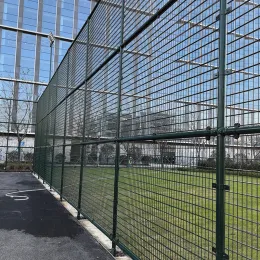Fences are often an overlooked aspect of property security, yet they play a vital role in safeguarding various types of properties, whether they belong to commercial entities, industrial operations, or sensitive installations such as prisons. A pivotal question arises: how tall should a security fence be?
The main function of a security fence is to keep unwanted individuals at bay. This might seem simple, but the height of your fence can greatly influence how effective it is. Typical residential fences stand at about 4 to 6 feet tall, which might deter casual trespassers; however, such height might prove inadequate when dealing with motivated intruders.

To qualify as a security fence, it must be a minimum of 6 feet tall. This height is merely the starting point and is often sufficient for areas classified as low-risk. Yet, security fences are generally built to around 8 feet tall, which offers a more substantial barrier against potential invaders.
In commercial and industrial settings, the need for taller fences becomes more pronounced. An 8-foot fence is commonplace in these areas. The increased height not only poses a greater challenge for climbers but also communicates that security is taken seriously. For high-risk industrial sites, fences may even be constructed to reach heights of 10 feet or more to bolster security further.
In high-security zones such as prisons or military facilities, the need for height escalates dramatically. Fences can stretch up to 14 feet or beyond. These imposing barriers are intended to be incredibly difficult to scale, posing a significant challenge to anyone attempting to compromise the perimeter.
While the height of the fence is a crucial measure of security, it's not the sole factor. Installing fence toppers such as barbed wire, razor wire, or electric fencing can provide an additional layer of deterrence, especially in high-threat areas.
Security considerations should not be limited to above-ground features. Extending your fence below ground can deter intruders from digging their way in. A solid foundation, including a bottom rail, can significantly enhance security.
Blending technology with your security fence can amplify its effectiveness. The integration of motion sensors, surveillance cameras, and alarm systems can notify property owners of any intrusions, allowing for immediate response and real-time security oversight.
While height is pivotal, it's essential to balance it with other considerations. In some cases, excessively tall fences may not only appear imposing but might also breach local regulations and impact the overall aesthetics. Here are some key factors to ponder:
Before erecting a towering fence, it is vital to consult local regulations. There may be legal limits on the height of fences, particularly in residential neighborhoods, and permits might be necessary for heights exceeding certain limits.
Security is paramount, but a fence can be effective while also being visually appealing. It’s possible to design a security fence that harmonizes with the environment while fulfilling security requirements, exploring various materials and designs to achieve this balance.
Building taller fences and implementing supplementary security measures will generally incur higher costs. It’s crucial to weigh your security needs against your budget. Sometimes, a fence of moderate height paired with advanced security features can be as effective as a taller structure.
The ideal height for a security fence ultimately depends upon your specific requirements and the level of security needed. Most commercial and industrial properties can be well-secured with an 8-foot fence, supported by additional security measures. For high-security locations, heights may need to reach up to 14 feet or more, along with deterrents like razor wire and electronic monitoring systems.
In conclusion, no fence can ensure 100% security, but by selecting an appropriate height and complementing it with other safety measures, you can establish a robust barrier that significantly enhances the security of your property.

Comments
0